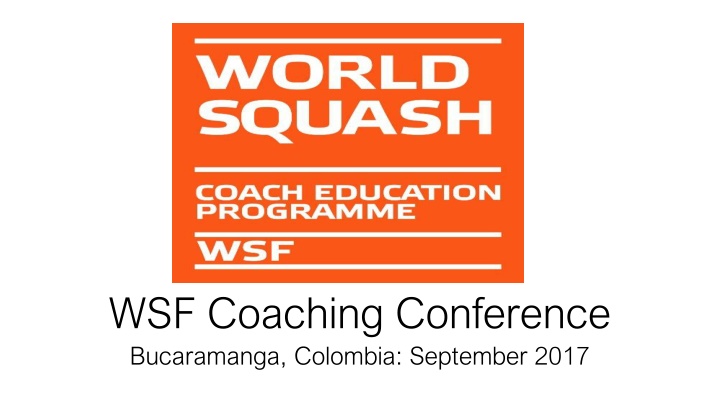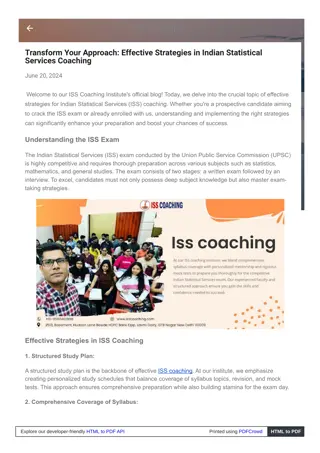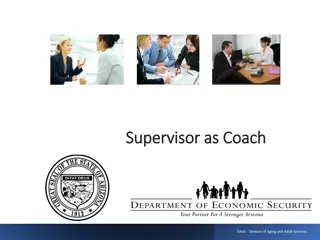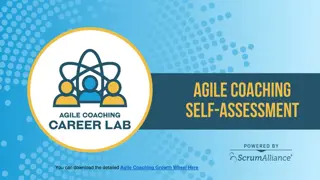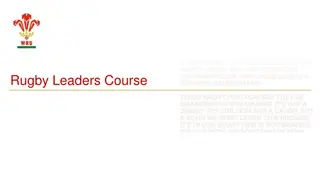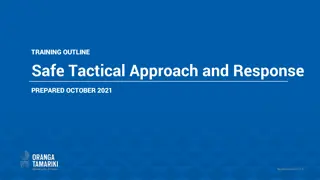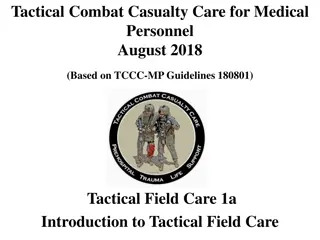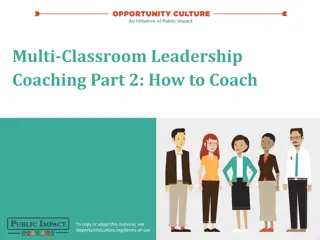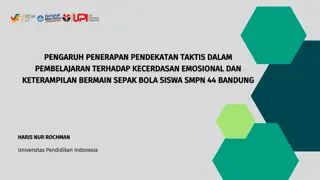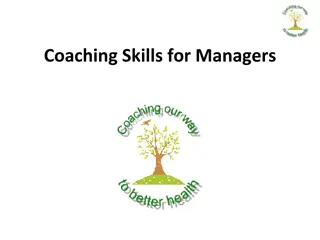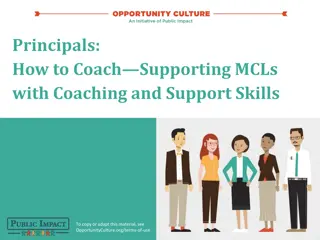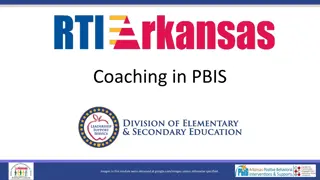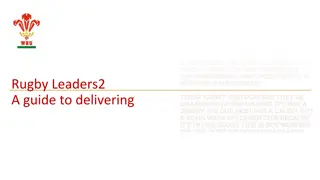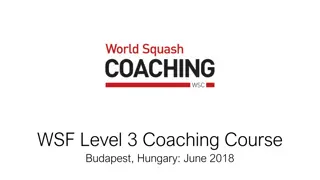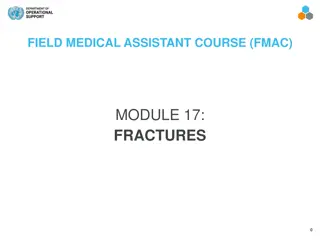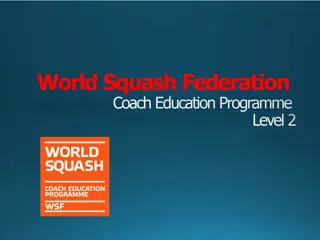Tactical Progressions for Enhanced Learning in Coaching
Discover the journey of Colin White, an experienced coach with a passion for enhancing player performance through tactical progressions. Explore the concept of structured practice to support game-based learning and create a tactical advantage for players. Learn from key coaching conferences and insights shared by industry experts. Unveil the importance of tactical progressions in improving anticipation, perception, and decision-making skills in a player-centered approach.
Uploaded on Oct 02, 2024 | 1 Views
Download Presentation

Please find below an Image/Link to download the presentation.
The content on the website is provided AS IS for your information and personal use only. It may not be sold, licensed, or shared on other websites without obtaining consent from the author.If you encounter any issues during the download, it is possible that the publisher has removed the file from their server.
You are allowed to download the files provided on this website for personal or commercial use, subject to the condition that they are used lawfully. All files are the property of their respective owners.
The content on the website is provided AS IS for your information and personal use only. It may not be sold, licensed, or shared on other websites without obtaining consent from the author.
E N D
Presentation Transcript
WSF Coaching Conference Bucaramanga, Colombia: September 2017
Tactical Progressions Using Traffic Lights & Corner Court System Colin White September 2017
Colin White: About me Picture o f colin Age: 47, Dad to a 2 Years old Boy (Patrick) Playing - 38 years / Coaching - 28 years WSF Tutor Level 1, Level 2 ESF Tutor Level 1, Level 2 and Level 3 Coach to Mark Krajcsak (PSA No.37) 12 x Hungarian Champion Austrian National Men's Coach 2013-15 Spinning Instructor, qualified New York 2011 TRX Instructor, qualified Bermuda 2011
My Journey: The (Un)Usual Suspects 1979-2002 Limited, hard working Coach/Player. Taught to watch the ball. Kept asking myself, What is it that a better player sees? 2002: ESF Coaching Conference: Paul Frank (Quarter/Corner Courts) 2005: WSF Coaching Confernce: Sarah Fitz-Gerald (Combinations) 2006: Roger Flynn: Patterns of Play 2010: Mike Harris: Traffic Lights 2010: ESF Level 2 Tutor Course: Peter Hirst (The Big Picture) 2010-2017: ESF Coaching Committee: Peter, Michael, Ronny. Envirnoment were we respectfully, challenge each other. A place to share ideas, a place to grow........
THE (UN)USUAL SUSPECTS Mike Hockney Harris, Roger McManus Flynn, Paul Fenster Frank, Sarah Keaton Fitz-Gerald, Peter Keyser Soze Hirst (The Man With The Plan)
What Are Tactical Progressions? What: A process of structured practice, designed to support the game based learning and focuses the Player on the intention to create a tactical advantage. Why: It enhances the anticipation/perception/decision process, providing the Player with additional time. When: It needs to become an intergral part of the learning process of Coaching- Practice-Games on a regular basis, to ensure learning is taking place for a match situation. How: By creating a progressive structure of drills that enhances the learning process. It works by dividing the front wall into specific heights for the Player to focus on overall accuracy.
Why Tactical Progressions? Ironman fights Captain America https://www.youtube.com/watch?v=zG0VMbcwshA https://www.youtube.com/watch?v=zG0VMbcwshA
What Are Traffic Lights? Red Zone: More Height and Depth = More time to recover to the T-zone. Yellow Zone: Less Height and Depth than Red, but more Power = Less time and more pressure on the opponent. Green Zone: Less Height and Depth than Yellow, but more Power = Less time and additional pressure on the opponent. Green Zone would also include shots like Drop and straight Kill.
What Is The Corner Court System? What: By breaking up the floor, into corner sections, we can set the Player clear targets to help the development of Linking Action to Result. Targets on the floor also helps us teach angles and weight of shot. Why: When trying to throw something with precision, we need to set clear targets. This would help with accuracy and allow for instant feedback and adjustments. When: The principal of hitting a ball with a clear target/aim should be done for every shot! How: Using the Short Line as the middle line and the Half Court Line to run up through the middle, we break the court into 4 Corners. We can put tape down to clearly mark the sections.
What Is The Corner Court System? C2 C3 C1 C4
Questions to ask that could help the process, but not limited to: 1 (Internal Q&A Focus?) What do I want my player to do? Why do I want them to do it? When should they do it? How do you produce it and what are the targets? What are the benefits/negatives to hitting each zone? What are they trying to achieve?
Questions to ask that could help the process, but not limited to: 2 (External Q&A Focus?) What does it look like when you force/allow your opponent to hit a certain zone? Does this help Anticipation and Deception? What influences the shot I will hit and where I will choose to have my point of impact? When and Why do we play a certain shot? When and How do we add Deception? When and How do we bring in the information about the 4/6/8/10 Corners and their meaning?
Tactical Progression 1 Tactical Progression 1 What: I want my players to move their feet (Happy Feet), to consistently find a suitable position and racket preparation. While doing this, they must also read the clues/preferences of their opponent. Why: This would allow the player a good balanced position, so they could use their grip (control) to hit shots with accuracy and power, to different heights/ lengths and gain control of the T Zone. Our aim is for the Player to use the time gained to develop Anticipation-Perception. When: In practice sometimes we need to be more explicit on what we want our players to do, so they can reproduce under pressure. Also some players have not been taught to "use the whole front wall". How: Pairs hitting to C1, using Traffic Lights: 1-2 minutes to each zone, depending on level off players and how much they have used the system before. Red Zone Yellow Zone Green Zone Red, Red, Yellow, Yellow, Green, Green, Player 1 option of the 3, Red, Red, Yellow, Yellow, Green, Green, Player 2 option of the 3. Conditioned Game at match speed, to 5 Points, serve from right side and the ball must bounce in the width of the service box, with the 1st or 2nd bounce landing in C1. Here we have started with Show, then moving to the Test in a "controlled" Open Skill
Tactical Progression Tactical Progression 2 2 What: Pairs hitting to C1, using Traffic Lights, with limited option to apply pressure into C3. Why: As the Player gets control of the T Zone, we would want them to attack. When: Once they have applied pressure, they must read the visual cues to take the tactical advantage, to hit away from their opponent. How: New added shots, Boast (Volley) or Crosscourt Flick (Volley)(1st and 2nd bounce inside C3 to teach weight of shot). Start as a Cooperative Rally, leading into a Cooperative Game then a Conditioned Game at match speed, to 5 Points, serve from right side and the ball must bounce in the width of the service box, with the 1st or 2nd bounce landing in C1, with the option to hit a Boast (Volley) or Flick (Volley). When ball is hit into C3, must be returned by Crosscourt Lob.
Tactical Progression Tactical Progression 3 3 What: What: Pairs hitting to C1, using Traffic Lights, with limited option to attack/apply pressure into C3. Plus the chance for them to be counter-attacked, when they play a poor shot, pick the wrong option or time to hit short. Why: Why: By adding the counter drop, we are developing their decision making skills. Instant feedback when they make a bad decision. Having the different shots also brings in the option of deception. When: When: Once they have applied pressure, creating the opening , they must read the clues and we would want them to hit away from their opponent. If this has happened at the wrong time or Player hangs back, then we would want a counter drop to be played. How: How: The same shots are used to take the ball into C3, Boast (Volley) or Crosscourt Flick (Volley) (1st and 2nd bounce inside C3 to teach weight of shot). New added shot is Drop option, when the ball has been played into C3. From the drop, ball must be returned to C1 using Crosscourt Lob.
Tactical Progression Tactical Progression 4 4 What: Pairs hitting to C1, using Traffic Lights, with limited option to attack/apply pressure into C3, which opens up C4 option: Why: The tactical progression is built around the player controlling the T Zone and attacking the front right corner at a good time, if not they open up the court, allowing themselves to be counter-attacked When: We would encourage the player to hit the crosscourt lob when under pressure, counter drop when ball is loose or opponent hanging back. Straight Length can be played as a lifting shot (Red Zone) working shot (Yellow Zone) or attacking shot (Green Zone). How: The same shots are used to take the ball into C3, Boast (Volley) or Crosscourt Flick (Volley) (1st and 2nd bounce inside C3 to teach weight of shot).Player, when taken into C3 now has the Straight Drop option, Crosscourt Lob or the new straight length to C4. With either Pairs or 3's do the Show and Test for the new shot added.
Tactical Progression Tactical Progression 5 5 What: Conditioned Game, with both players keeping to the conditions. Why: This could be used to encourage a player who hits too many boasts into the front left corner, to find different solutions. When: With the restricted area, this could cut down the options from certain areas and allow the players more time to read the clues at match speed. How: Serve as normal and play a game to 11, but working to the conditions. Do the players use the clues/information they should have learned about their opponent, to have better Anticipation, Perception Deception and does this help their decision making skills?
Tactical Progression Tactical Progression 6 6 What: Conditioned Game, with only one player keeping to the conditions, the other playing to the whole court. Why: This could be used to starve the front left area of an opponent who is strong there, maybe a left-handed player for example, but this time the opponent could be trying to force the player to hit into this area. When: This takes the Player into match speed and forces them to reproduce the tactic, while their opponent hits to the full court. How: Serve as normal and play a game to 11. After one set, players could switch roles. Do the players use the cues/information they should have learned about their opponent, to have better Anticipation/ Deception skills and does this help their decision making skills? If not, why not? Feedback/Discussion with Player: What went well? What didn t go so well? What do we need to adjust for the next session?
Conclusions My journey with The Unusal Suspects, but I did not want to be a copy/paste Coach. I beg, borrowed, stole but tried to develop the process in connection to my players and myself. During my Tutor Courses, always here We need more drills . Do we really or as Coaches do we need to adjust the Area of Focus, to help the Player become more skilful in this wonderful, super fast, open-skilled sport? This is one way I try to do that! Questions? My Story: Asked as an 11 year old player, what did I want to do, when I grow up?
